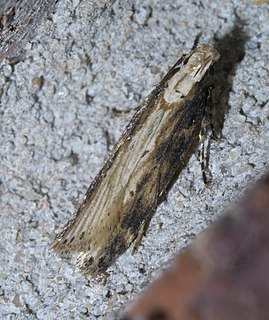| Chionodes gilvomaculella | |
|---|---|
| Scientific classification | |
| Kingdom: | |
| Phylum: | |
| Class: | |
| Order: | |
| Family: | |
| Genus: | |
| Species: | C. gilvomaculella |
| Binomial name | |
| Chionodes gilvomaculella (Clemens, 1863) | |
| Synonyms | |
| |
Chionodes gilvomaculella is a moth in the family Gelechiidae. [1] It is found in North America, where it has been recorded from Nova Scotia and southern Ontario to West Virginia and Ohio. [2] [3]

Moths comprise a group of insects related to butterflies, belonging to the order Lepidoptera. Most lepidopterans are moths, and there are thought to be approximately 160,000 species of moth, many of which have yet to be described. Most species of moth are nocturnal, but there are also crepuscular and diurnal species.

The Gelechiidae are a family of moths commonly referred to as twirler moths or gelechiid moths. They are the namesake family of the huge and little-studied superfamily Gelechioidea, and the family's taxonomy has been subject to considerable dispute. These are generally very small moths with narrow, fringed wings. The larvae of most species feed internally on various parts of their host plants, sometimes causing galls. Douglas-fir (Pseudotsuga) is a host plant common to many species of the family, particularly of the genus Chionodes, which as a result is more diverse in North America than usual for Gelechioidea.

North America is a continent entirely within the Northern Hemisphere and almost all within the Western Hemisphere. It is also considered by some to be a northern subcontinent of the Americas. It is bordered to the north by the Arctic Ocean, to the east by the Atlantic Ocean, to the west and south by the Pacific Ocean, and to the southeast by South America and the Caribbean Sea.
The forewings are dark brownish, with an indistinct yellowish spot on the costa near the base of the wing and one of the same colour on the middle of the costa, extended indistinctly or diffusely to the fold, where there is a blackish-brown spot. A yellowish streak is found on the costa near the tip, with an opposite one of the same colour on the inner margin. The hindwings are dark greyish. [4]
The larvae feed on Quercus species.

